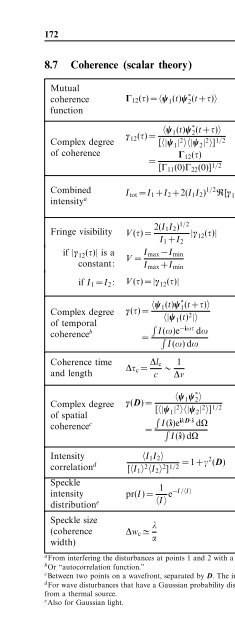You also want an ePaper? Increase the reach of your titles
YUMPU automatically turns print PDFs into web optimized ePapers that Google loves.
172 Optics<br />
8.7 Coherence (scalar theory)<br />
Mutual<br />
coherence<br />
function<br />
Complex degree<br />
<strong>of</strong> coherence<br />
Combined<br />
intensity a<br />
Γ 12 (τ)=〈ψ 1 (t)ψ ∗ 2(t+τ)〉 (8.97)<br />
γ 12 (τ)= 〈ψ 1(t)ψ ∗ 2(t+τ)〉<br />
[〈|ψ 1 | 2 〉〈|ψ 2 | 2 〉] 1/2 (8.98)<br />
=<br />
Fringe visibility V (τ)= 2(I 1I 2 ) 1/2<br />
if |γ 12 (τ)| is a<br />
constant:<br />
Γ 12 (τ)<br />
[Γ 11 (0)Γ 22 (0)] 1/2 (8.99)<br />
I tot = I 1 +I 2 +2(I 1 I 2 ) 1/2 R[γ 12 (τ)]<br />
(8.100)<br />
I 1 +I 2<br />
|γ 12 (τ)| (8.101)<br />
V = I max −I min<br />
I max +I min<br />
(8.102)<br />
if I 1 = I 2 : V (τ)=|γ 12 (τ)| (8.103)<br />
Γ ij<br />
τ<br />
ψ i<br />
mutual coherence function<br />
temporal interval<br />
(complex) wave disturbance<br />
at spatial point i<br />
t time<br />
〈·〉 mean over time<br />
γ ij complex degree <strong>of</strong> coherence<br />
∗ complex conjugate<br />
I tot<br />
I i<br />
R<br />
combined intensity<br />
intensity <strong>of</strong> disturbance at<br />
point i<br />
real part <strong>of</strong><br />
I max max. combined intensity<br />
I min min. combined intensity<br />
Complex degree<br />
<strong>of</strong> temporal<br />
coherence b<br />
γ(τ)= 〈ψ 1(t)ψ ∗ 1(t+τ)〉<br />
〈|ψ 1 (t) 2 (8.104)<br />
|〉<br />
∫<br />
I(ω)e −iωτ dω<br />
= ∫ (8.105)<br />
I(ω)dω<br />
γ(τ) degree <strong>of</strong> temporal coherence<br />
I(ω) specific intensity<br />
ω radiation angular frequency<br />
c speed <strong>of</strong> light<br />
Coherence time<br />
and length<br />
Complex degree<br />
<strong>of</strong> spatial<br />
coherence c<br />
∆τ c = ∆l c<br />
c ∼ 1 ∆ν<br />
(8.106)<br />
〈ψ<br />
γ(D)=<br />
1 ψ ∗ 2〉<br />
(8.107)<br />
[〈|ψ 1 | 2 〉〈|ψ 2 | 2 〉]<br />
∫ 1/2 I(ŝ)e ikD·ŝ dΩ<br />
= ∫ (8.108)<br />
I(ŝ)dΩ<br />
Intensity<br />
〈I 1 I 2 〉<br />
correlation d [〈I 1 〉 2 〈I 2 〉 2 ] 1/2 =1+γ2 (D) (8.109)<br />
∆τ c<br />
∆l c<br />
∆ν<br />
coherence time<br />
coherence length<br />
spectral bandwidth<br />
γ(D) degree <strong>of</strong> spatial coherence<br />
D spatial separation <strong>of</strong> points 1<br />
and 2<br />
I(ŝ) specific intensity <strong>of</strong> distant<br />
extended source in direction ŝ<br />
dΩ differential solid angle<br />
ŝ<br />
unit vector in the direction <strong>of</strong><br />
dΩ<br />
k wavenumber<br />
Speckle<br />
intensity<br />
distribution e pr(I)= 1<br />
〈I〉 e−I/〈I〉 (8.110) pr probability density<br />
∆w<br />
Speckle size<br />
c characteristic speckle size<br />
(coherence ∆w c ≃ λ λ wavelength<br />
(8.111)<br />
width)<br />
α<br />
α source angular size as seen<br />
from the screen<br />
a From interfering the disturbances at points 1 and 2 with a relative delay τ.<br />
b Or “autocorrelation function.”<br />
c Between two points on a wavefront, separated by D. <strong>The</strong> integral is over the entire extended source.<br />
d For wave disturbances that have a Gaussian probability distribution in amplitude. This is “Gaussian light” such as<br />
from a thermal source.<br />
e Also for Gaussian light.


